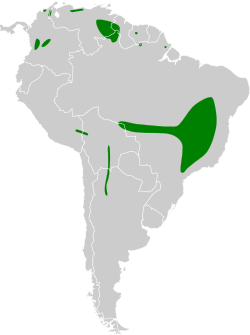| Stripe-tailed yellow finch | |
|---|---|
 | |
| Stripe-tailed yellow finch at Serra do Cipó, Minas Gerais State, Brazil | |
| Scientific classification | |
| Kingdom: | Animalia |
| Phylum: | Chordata |
| Class: | Aves |
| Order: | Passeriformes |
| Family: | Thraupidae |
| Genus: | Sicalis |
| Species: | S. citrina |
| Binomial name | |
| Sicalis citrina Pelzeln, 1870 | |
 | |
The stripe-tailed yellow finch (Sicalis citrina) is a species of bird in the family Thraupidae. It is found in Argentina, Bolivia, Brazil, Colombia, Guyana, Paraguay, Peru, Suriname, and Venezuela. Its natural habitats are dry savanna and pastureland.
